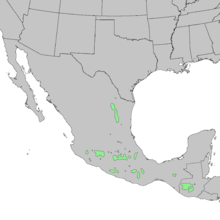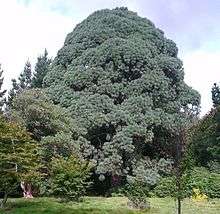Pinus montezumae
Pinus montezumae, known as the Montezuma pine, is a species of conifer in the family Pinaceae.
| Pinus montezumae | |
|---|---|
| Scientific classification | |
| Kingdom: | Plantae |
| Clade: | Tracheophytes |
| Division: | Pinophyta |
| Class: | Pinopsida |
| Order: | Pinales |
| Family: | Pinaceae |
| Genus: | Pinus |
| Subgenus: | P. subg. Pinus |
| Section: | P. sect. Trifoliae |
| Subsection: | P. subsect. Ponderosae |
| Species: | P. montezumae |
| Binomial name | |
| Pinus montezumae Lamb.[2] | |
 | |
| Natural range of Pinus montezumae | |
It is native to Mexico and Central America, where it is known as ocote. The tree grows about 35 m high and 80 cm in diameter; occasionally it may reach a height of 40 m and diameter of 1 m. It has a round crown. The bark is dark brown-grayish.
It is found from the Mexican states of Nuevo León (25° N. Lat.) and Jalisco (22° n.l.) to the north and to Nicaragua (15° N. Lat.) to the south. It occurs on both mountain ranges of the Sierra Madre Oriental and Sierra Madre Occidental. It grows at altitudes from 2000–3200 m above sea level. It is found in areas between 800–1000 mm rainfall per year. In most of the tree's habitat, rain falls mostly in summer, but in the state of Veracruz, precipitations are spread year round and the climate is very wet. However, specimens from the state of Jalisco grow in semi-arid places. It occurs in warm temperate to cool climates (18 °C to 10 °C). At the highest altitudes of its distribution it usually receives snow in the winter.

Ocote wood is yellowish-brown white, with the heartwood being light brown, is hard, heavy and used for construction. It is appreciated for its resin. The resin is so flammable that a cut branch will burn as a torch emitting black smoke when ignited; for this reason, it is very common in Mexico to use ocote wood as a fire starter for campfires and barbecues. Growth is slow in the first three or six years, after this stage it is a fast-growing tree. The cities of Ocotlán in Jalisco Mexico and Ocotal in Nicaragua derive their names from this tree. It is planted in plantages in South Africa and Queensland, Australia at mid altitudes; in Kenya, Malawi, Botswana, Zimbabwe and Bolivia at high altitudes. Trees planted in New Zealand and New South Wales, Australia near sea level have done very well.
References
- Farjon, A. (2013). "Pinus montezumae". IUCN Red List of Threatened Species. 2013: e.T42382A2976574. doi:10.2305/IUCN.UK.2013-1.RLTS.T42382A2976574.en.
- "Pinus montezumae". Germplasm Resources Information Network (GRIN). Agricultural Research Service (ARS), United States Department of Agriculture (USDA). Retrieved 16 May 2008.
Further reading
- Dvorak, W. S., G. R. Hodge, E. A. Gutiérrez, L. F. Osorio, F. S. Malan and T. K. Stanger. 2000. Conservation and Testing of Tropical and Subtropical Forest Species by the CAMCORE Cooperative. College of Natural Resources, NCSU. Raleigh, NC. USA.
- Richardson D.M. (Ed) 2005. Ecology and biogeography of Pinus. Department of Conservation. South Island Wilding Conifer Strategy. New Zealand.
- Chandler, N.G. "Pulpwood plantations in South Africa". Proc. Aust. Paper Indus. Tech. Ass.
External links


